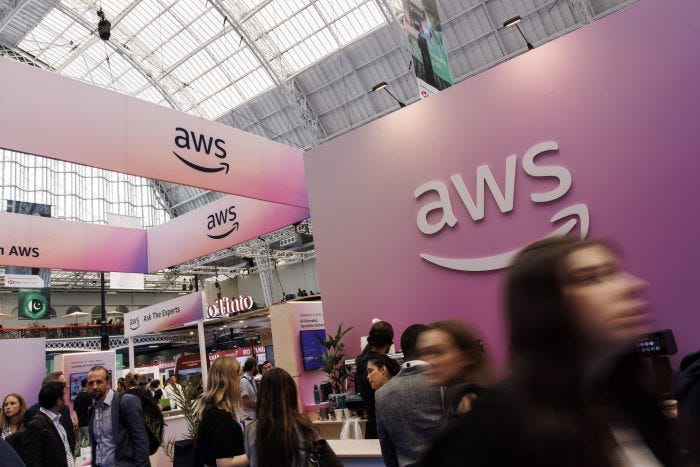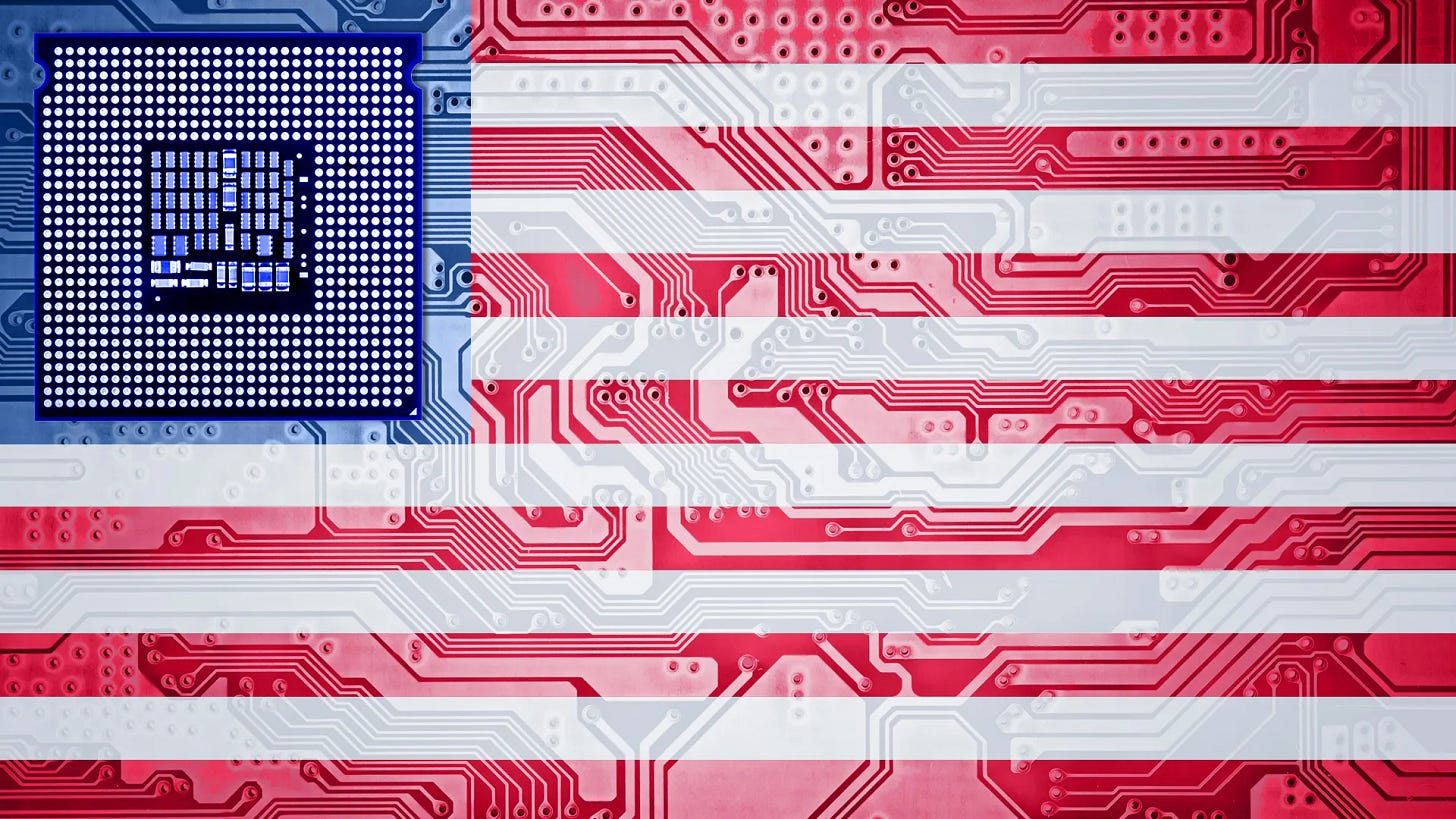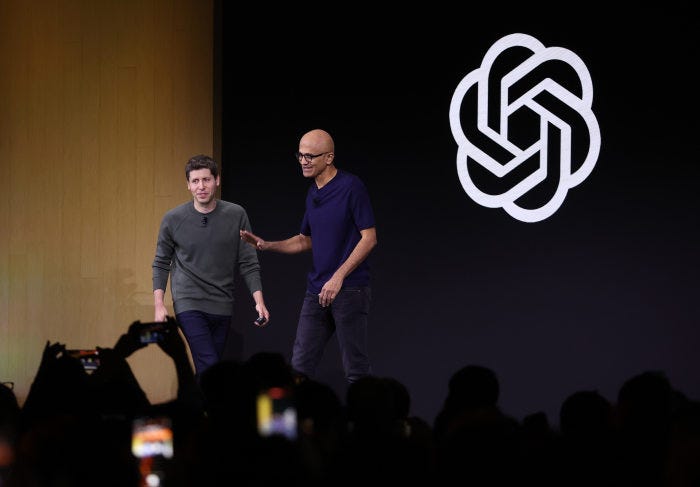
AI: OpenAI's bigger than life role in this AI Tech Wave. RTZ #895
It’s November 2025, and AI Data Center & Power capex boom is driving most of the US quarterly GDP growth. The earnings results of most of the big tech Mag 7 had investor focus mostly on AI capex, with post market reactions up or down.
Wall Street for now is greenlighting it all despite gnarly doubts in the back of their minds that it could all unravel if AI demand this AI Tech Wave doesn’t show up in time to meet the fast-growing AI Intelligence token Compute Supply.
And OpenAI of course is at the front in these AI laps of course, with yet another multi-billion dollar AI Compute deal, this time with Amazon’s AWS cloud service.
Not to diminish Nvidia’s front and center role in all this of course.
But OpenAI is rapidly continuing its diversification away from Microsoft Azure, now that the ‘separation’ agreements have been drawn. And signing bigger and bigger deals $1.4 trillion and counting on an impressive $13 billion in revenues to date.
And Sam Altman vociferously defending it all aggressively on a recent podcast with Microsoft CEO Satya Nadella. And its PR kerfuffle thereafter.
So the question of course arises that where goes OpenAI, must go the AI market from an investors perspective, both private and public. AGI dreams an all.
The WSJ posits and discusses this well in “Is OpenAI Becoming Too Big to Fail?”:
“Sam Altman’s ability to intertwine the startup throughout major tech players puts it at the nexus of a vital part of the U.S. economy.”
“Slowly then all at once, OpenAI became something of a juggernaut that’s hard to fully fathom.”
“It hasn’t yet turned a profit. Its annual revenue is 2% of Amazon.com’s sales. Its future is uncertain beyond the hope of ushering in a godlike artificial intelligence that might help cure cancer and transform work and life as we know it. Still, it is brimming with hope and excitement.”
“But what if OpenAI fails?”
Exhibit 1 of course are all those circular AI deals:
“There’s real concern that through many complicated and murky tech deals aimed at bolstering OpenAI’s finances, the startup has become too big to fail.”
“Or, put another way, if the hype and hope around Chief Executive Sam Altman’s vision of the AI future fails to materialize, it could create systemic risk to the part of the U.S. economy likely keeping us out of recession.”
“That’s rarefied air, especially for a startup. Few worried about what would happen if Pets.com failed in the dot-com boom.”
“We saw in 2008-09 with the bank rescues and the Chrysler and General Motors bailouts what happens in the U.S. when certain companies become too big to fail.”
“Altman—by design or happenstance—has engineered OpenAI’s rise to a $500 billion valuation just as the Trump administration has embraced its own policies of picking champions in the name of national defense and economic security.”
All with full throated Wall Street support of course to date:
“The White House has been very vocal in efforts to protect AI development in the U.S., which is helping fuel what otherwise would be a much slower economy. More than that, some are betting that AI and robotics will be the salve to our nation’s debt troubles.”
“An economy that’s over $30 trillion in debt needs the productivity boost that AI is going to give us,” tech investor David Sacks said on social media years ago before becoming the White House AI czar.”
The broader societal AGI goals of OpenAI are of course constantly underlined, complete with roadmap:
“In a blog post Tuesday, OpenAI Chair Bret Taylor marked the moment, declaring: “Built to benefit everyone.”
“It’s the kind of altruistic talk Altman is known for as he predicts that superintelligent AI—or AGI—will help cure cancer and save humanity.”
“I think AGI is probably necessary for humanity to survive—our problems seem too big to solve…without better tools,” Altman tweeted a few years ago.”
“Microsoft, which will hold a 27% stake, saw its shares rise on the latest news, pushing its market value past $4 trillion. (Later in the week, Nvidia, which had previously announced plans to invest $100 billion into OpenAI, became the first $5 trillion company.)”
But recent history is echoing and rhyming in many minds:
“The linkages between these tech behemoths and the stock market’s dependence on them are notable. The lessons of the financial crisis earlier this century weren’t just that the banks were too big to fail, they were too interconnected to fail.”
“The big financial institutions were intertwined by a web of complex financial instruments and vehicles that threatened to bring down the U.S. system as certain players teetered toward collapse. This led the U.S. government to step in with a bailout package as well as take other unusual measures.”
“Nobody is saying OpenAI is dabbling in anything like liar loans or subprime mortgages. But the startup is engaging in complex deals with the key tech-industry pillars, the sorts of companies making the guts of the AI computing revolution, such as chips and Ethernet cables.”
And the glass half full case, argued by Meta and others, bears keeping in mind of course:
“Those companies, including Nvidia and Oracle, are partnering with OpenAI, which in turn is committing to make big purchases in coming years as part of its growth ambitions.”
“Supporters would argue it is just savvy dealmaking. A company like Nvidia, for example, is putting money into a market-making startup while OpenAI is using the lofty value of its private equity to acquire physical assets.”
“They’re rooting for OpenAI as a once-in-a-generational chance to unseat the winners of the last tech cycles. After all, for some, OpenAI is the next Apple, Facebook, Google and Tesla wrapped up in one. It is akin to a company with limitless potential to disrupt the smartphone market, create its own social-media network, replace the search engine, usher in a robot future and reshape nearly every business and industry.”
And the driving motivation of tech CEOs afraid of missing it all is palpable:
““I think the industry is underrating and underinvesting given the scale,” Microsoft AI CEO Mustafa Suleyman told me the other day during our appearance at a Paley Center for Media event in Menlo Park, Calif.”
“Suleyman was sidestepping concerns raised about OpenAI becoming too big to fail. Instead, he painted a more optimistic picture, pointing to how investments in AI have already shown “truly exponential improvement in capabilities” and saying that future spending will “drive incredible improvements in capabilities.” The sort of capabilities, he added, that will upend “basically every industry.”
“To others, however, OpenAI is something akin to tulip mania, the harbinger of the Great Depression, or the next dot-com bubble. Or worse, they see, a jobs killer and mad scientist intent on making Frankenstein.”
“But that’s counting on OpenAI’s success.”
The whole piece is worth a full read for additional nuance and color.
But the question on this AI Tech Wave, is a timely one this penultimate month of 2025. Only a thousand or so days after OpenAI’s ‘ChatGPT moment’ the penultimate month of 2022. Is “OpenAI is too big to fail?” Stay tuned.
(NOTE: The discussions here are for information purposes only, and not meant as investment advice at any time. Thanks for joining us here)














